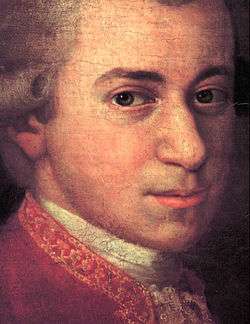Symphony No. 12 (Mozart)
Symphony No. 12 in G major, K. 110/75b, by Wolfgang Amadeus Mozart, was composed in Salzburg in the summer of 1771. The symphony was apparently prepared in anticipation of Mozart's second Italian journey, which was to take place between August and December 1771.[1] The symphony is in four movements, the opening allegro being the longest movement that Mozart had written to that date. It is the first of a group of works "painted on a larger canvas and achieving a greater individuality than his earlier exuberant pieces".[2]
Movements and instrumentation
The instrumentation was: strings, 2 oboes, 2 horns, 2 flutes, 2 bassoons, continuo[1]
The minuet features a canon between high and low strings at the interval of a single bar. Mozart likely learned this technique from Joseph Haydn's 23rd Symphony from 1764 (also in G major).[3]
Performance details
There are no confirmed details as to first performance. It is possible that this symphony was first played at a concert in Milan, on 22nd or 23 November 1771.
References
- 1 2 Zaslaw, pp. 209–12
- ↑ Kenyon, p. 156
- ↑ H. C. Robbins Landon, Haydn: Chronicle and Works, 5 vols, (Bloomington and London: Indiana University Press, 1976-) v. 1, Haydn: the Early Years, 1732-1765
Sources
- Kenyon, Nicholas: The Pegasus Pocket Guide to Mozart Pegasus Books, New York 2006 ISBN 1-933648-23-6
- Zaslaw, Neal: Mozart's Symphonies: Context, Performance Practice, Reception OUP, Oxford 1991 ISBN 0-19-816286-3
External links
- Symphony in G K. 110: Score and critical report (German) in the Neue Mozart-Ausgabe
- Symphony No. 12: Scores at the International Music Score Library Project
